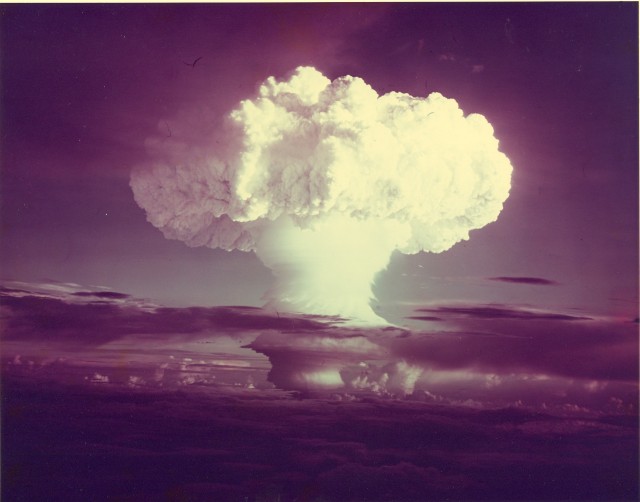On November 1, 1952, the United States tested its first hydrogen bomb. Joint Task Force 132 was designated by President Harry S. Truman as responsible for OPERATION IVY. The task force included Army, Navy, and Air Force components plus numerous distinguished scientists. Task Force 132 began preparing Eniwetok for testing in March of 1952. More than nine thousand military personnel and two thousand civilians had moved into the area, living either on board ships or on surrounding islands. The sea adjacent to the atoll contained one aircraft carrier and four destroyers. The first hydrogen bomb was prepared by the Atomic Energy Commission and the Defense Department aboard a naval ship heading toward Eniwetok. More than eighty aircraft were kept on alert nearby for transport and for aerial testing by the Air Force. It was seemingly easy for the task force to decide where to carry out this mammoth test as the United States had used the Eniwetok Atoll for several years prior to the detonation of the world's first hydrogen bomb.
Eniwetok Atoll is part of the Marshall Islands in the South Pacific. Before World War I, Germany had control of the land and surrounding waters. The Japanese captured the islands in 1914, and as a result, the League of Nations mandated the area to Japan in 1920. However, during World War II, United States forces captured the entire island group. It remained an American possession for over forty years after World War II, until the Marshall Islands became independent in 1986.
Eniwetok consists of forty small islets and atolls, spread out into the shape of an oval ring. The ring measures twenty miles long and ten miles wide with two entrances into the center lagoon. This site had been used for nuclear weapons testing since 1947. Testing included OPERATION SANDSTONE, three atomic bombs that were detonated during April and May of 1948. Although World War II had ended, the Cold War was heating up. Therefore, on January 31, 1950, President Truman ordered the Atomic Energy Commission to continue its work on all forms of nuclear weapons, including the so-called hydrogen or super-bomb. Hydrogen bombs are a type of nuclear weapon. The hydrogen bomb derived its name from the use of thermonuclear explosive devices using hydrogen isotopes.
OPERATION IVY consisted of two tests: Codename "Mike," on November 1, 1952, and Codename "King" on November 15. Mike was the first full-scale hydrogen explosive device to be tested. H-hour for the Mike bomb was at 7:15 on the morning of November 1 (October 31 in the continental U.S. time zone). Mike was carried out within the specific, set-apart, Pacific Proving Grounds. The task force chose one of Eniwetok's smaller islands, Elugelab, for Mike as that little outcrop of coral and sand was the greatest distance away from the large atoll island, Parry, the technical and scientific base. At least five hundred scientific stations, spread out over thirty islands, helped measure and analyze this first test of the hydrogen bomb.
Mike was detonated remotely, from the control ship Estes, thirty miles away from ground zero. The three-mile wide fire ball reached 57,000 feet in ninety seconds. One minute later it reached 108,000 feet and ultimately reached 120,000 feet. The mushroom cloud spread out 100 miles across. The yield was 10.4 Megatons (equivalent to 10.4 million tons of TNT), the first "megaton-yield" explosion to occur. The radius of the blast was ten times that of an atomic explosion and 1,000 times as powerful as an atomic blast. Mike's destructive blast, more than three megatons, contained as much force as that in the combined weight of all bombs dropped on Germany and Japan in World War II.
The island was completely vaporized. The crater that was left behind was 6,240 feet across and 164 feet deep. Atomic Energy Commission Chairman Gordon Dean summarized the results for the new President, Dwight D. Eisenhower: "the island of Elugelab is missing!"
OPERATION IVY was the first of many hydrogen bomb tests. Spurred on by the Cold War, the United States was attempting to create nuclear weapons that improved upon those used at Nagasaki and Hiroshima. Through the combined efforts of the U. S. Army, Navy, and Air Force, and expert scientists, this mission was accomplished.




Social Sharing